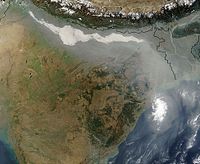
Photo from wikipedia
The atmospheric pollution has been the public attention in recent years. In order to better coordinate economic development and atmospheric environmental management, China introduced the concept of atmospheric environmental capacity… Click to show full abstract
The atmospheric pollution has been the public attention in recent years. In order to better coordinate economic development and atmospheric environmental management, China introduced the concept of atmospheric environmental capacity (AEC). The remaining atmospheric environmental capacity (RAEC) calculated by existing atmospheric pollution sources and AEC is an important basis for regional development and environmental protection. The RAEC of the high-pollution risk suburb of Chengdu in 2015 was estimated by the single-box model and analyzed on multiple time scales. The results show that the RAEC of SO2 and NO2 in this region is 3299 t/a and 2849 t/a, respectively under the annual time scale. However, in the daily time scale, the RAEC of NO2 is negative for 3 days, that is, there are 3 days with serious air pollution. Therefore, it is not appropriate to plan the industrial area only by relying on annual RAEC. Especially, RAEC displays inter-seasonal and monthly variability. On the one hand, in plain areas with low wind speed and little change in wind direction, achieving the prediction of atmospheric mixing layer height could give early warning of atmospheric pollution events. On the other hand, different management measures are taken on different time scales. On a long timescale, the regional energy structure should be optimized. On seasonal and monthly time scales, the production plans should be adapted to RAEC. On the daily time scale, it mainly deals with the serious atmospheric pollution accident timely.
Journal Title: Journal of environmental management
Year Published: 2020
Link to full text (if available)
Share on Social Media: Sign Up to like & get
recommendations!